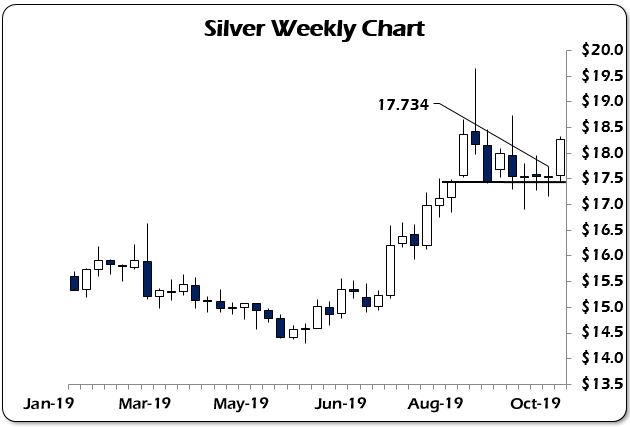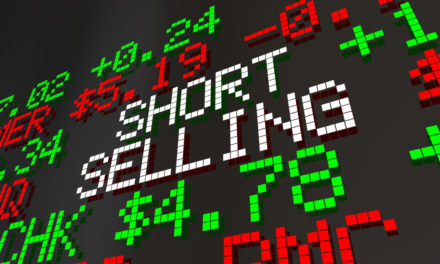Gold went on a tear earlier this year. Breaking down a nearly five-year old resistance barrier this summer, gold has held onto most of those gains and has bounced around after consolidating those gains.
Since the Fed began its new repo operations, which is now “Not QE4,” gold has been under very strong pressure to break down below recent lows near $1460 an ounce in the spot market.
It looked like the safe haven trade that dominated so much of the first half of 2019 was finally over as central banks stepped in to provide much-needed liquidity and reassure markets that the era of the “Central Bank Put” wasn’t over.
After the initial euphoria died down and stock markets failed to break to new highs, questions finally filtered in asking basic things like, “If everything’s so great why do we need QE?”
The short answer, of course, is that everything isn’t good. It’s the exact opposite of good.
For months the data coming out of Germany has been abysmal. The news coming out of German major banks like Deutsche Bank (NYSE:DB) and Commerzbank was worse. Moreover, no one in control has any answers as to why they are so bad.
All we hear from the departing vandal Mario Draghi is that more of what hasn’t worked is needed because the euro is “more popular than ever before.” If there’s one thing about Draghi that has not ever changed is that the man has chutzpah.
Yes, he’s right that many countries continue ditching the U.S. dollar to settle trade. And some partners, like Russia, are willing to shift some of that dollar demand into demand for euros. But, make no mistake, the Russians are not stupid.
They see the mess that Europe is in financially and see all those newly-issued and redenominated loans in euros getting paid back at $0.70 on the euro.
What is happening in Europe is chilling and it continues to put a bid underneath the metals as the ECB is now, officially tapped out of new options, with rates negative, youth unemployment at structurally high levels and a balance of payments nightmare that only ends with a complete reorganization of the Eurozone or collapse.
Mike Shedlock has a barn-burner of an article on his site talking about the degree of economic disintegration extant in the Eurozone which I encourage everyone to read. From the $1.2 trillion TARGET2 imbalances to the massive imbalances in youth unemployment, Mike details the problems at the heart of Europe.
After which he asks the most salient question of all.
What the Hell is the ECB Doing?
There are only two answers. One of them is very unsettling.
- Ignorance
- On Purpose
The EU is pushing for fiscal and political integration. It has most of the latter in place, the pesky problem of Brexit will most likely be resolved to their satisfaction soon. It is the lack of fiscal integration that plagues the EU in both the short and long term.
And the only way for that to occur is to force Germany to get on board with it, which they won’t. Unless, as Mike suggests, Draghi’s entire plan was to shuffle more than $800 billion in unpayable debt to Germany through TARGET2 and then blackmail them with default.
Is it any wonder that the Germans began buying gold again?
Central banks were 15% of gold demand in 2018 and that number is likely to be higher in 2019 as China’s purchases accelerate and the Russians can’t seem to buy gold fast enough.
But for Draghi and Europe they’ve enjoyed a bit of a reprieve in recent weeks as the euro rallied back above $1.11 amid news that a deal was reached between it and Boris Johnson’s government.
The EU needs this deal executed in its current form to reassure markets during the transition period and free trade negotiations that it still holds all the cards. That’s why they gave Johnson his win. That would buy them enough time to take Brexit uncertainty off the table while they deal with the fallout of Draghi’s vandalism and complete their fiscal integration and formally neuter opposition to it against the backdrop of German political paralysis.
For investors, silver is leading the charge here technically. After closing at the same price three weeks in a row(!!), silver busted back through $18.00 to throw an impressive reversal signal that blew away resistance and put it in the position for its second-highest weekly close in 2019.

Gold, on the other hand, is struggling at the $1515 level (again, spot market prices), which has acted as overhead resistance for weeks now. A definitive weekly close above that level, however, will pave the way for a re-test of this summer’s high and most likely far beyond that.
For the most part markets have chopped back and forth uncommitted because of the political uncertainty disrupting markets the world over. But this week’s signals from the metals are giving us a clue as to what we’re headed for in the coming weeks.
When Christine Lagarde takes over for Draghi next week along with the new European Commission we will see the reality of what Draghi set up over the past eight years. The EU has to make its final push for fiscal unity if it is to survive. It is this fatal flaw at the heart of the euro system that has led things to this point.
Draghi did his job. Now it’s Lagarde’s mandate to finish what he started.
They’ll take a massive upward revision in the price of gold to achieve his. After all, the ECB, unlike the Fed, marks its gold reserve to market value. And if it’s staring at hundreds of billions in write-downs, as Mike Shedlock suggests, creating conditions for a rising gold price blunts some of that pain.
• Money & Markets contributor Tom Luongo is the publisher of the Gold Goats ‘n Guns Newsletter. His work also is published at Strategic Culture Foundation, LewRockwell.com, Zerohedge and Russia Insider. A Libertarian adherent to Austrian economics, he applies those lessons to geopolitics, gold and central bank policy.




